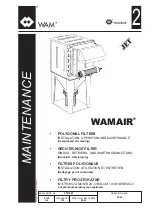
3
WARNING
1.
Read and understand the entire contents of this manual before attempting assembly or
operation. Do not use this machine until proper training and knowledge has been obtained.
2.
Do not leave Dust Collector when plugged in. Unplug from outlet when not in use and before
servicing.
3.
Do not use outdoors or on wet surfaces.
4.
Do not allow to be used as a toy. Close attention is necessary when used near children.
5.
Use only as described in this manual. Use only manufacturer’s recommended attachments.
6.
Do not use with damaged cord or plug. If Dust Collector is not working as it should, has been
dropped, damaged, left outdoor, or dropped in water, return it to a service center.
7.
Do not pull or carry by cord, use cord as a handle, close a door on cord, or pull cord around sharp
edges or corners. Do not run Dust Collector over cord. Keep cord away from heated surfaces.
8.
Do not unplug by pulling on cord. To unplug, grasp the plug, not the cord.
9.
Do not handle plug or Dust Collector with wet hands.
10. Do not put any objects into the openings. Do not use with any opening blocked; keep free of dust,
lint, hair, and anything that may reduce air flow.
11. Keep hair, loose clothing, fingers, and all parts of body away from opening and moving parts.
12. Do not pick up anything that is burning or smoking, such as cigarettes, matches, or hot ashes.
13. Do not use without dust bag and/or filter bag in place.
14. Turn off all controls before unplugging.
15. Do not use to pick up flammable or combustible liquids such as gasoline or use in areas where they
may be present.
16. Do not operate without hose connected to the inlet port. Hazardous moving parts inside. Unplug
machine before removing hose.
17. Some dust created by power sanding, sawing, grinding, drilling and other construction activities
contains chemicals known to cause cancer, birth defects or other reproductive harm. Some
examples of these chemicals are:
•
Lead from lead based paint
•
Crystalline silica from bricks and cement and other masonry products, and
•
Arsenic and chromium from chemically-treated lumber.
19. Your risk from those exposures varies, depending on how often you do this type of work. To
reduce your exposure to these chemicals: work in a well ventilated area, and work with approved
safety equipment, such as those dust masks that are specifically designed to filter out microscopic
particles
20. Do not operate tool while under the influence of drugs, alcohol or any medication.
21. Make sure the extension cord is in good condition. When using an extension cord, be sure to use
one heavy enough to carry the current your product will draw. An undersize cord will cause a drop
in the line voltage resulting in loss of power and overheating. The table below shows the correct
size to use depending on cord length and nameplate ampere rating. If in doubt, use the next
heavier gauge. The smaller gauge number, the heavier the cord.
22. Do not use dust collector for anything except wood dust. Materials such as liquids, metal shavings,
metal dust, screws, glass, plastic or rock can cause sparks and/or damage when coming into
contact with any part of the dust collector.
23. Ground your dust collector along all plastic components. The connection of bare 12 gauge copper
wire on all plastic hoses, fittings and blast gates to all machines will help reduce the occurrence of
static build up and discharge.
SAVE THESE INSTRUCTIONS
Summary of Contents for M-708640
Page 11: ...11 Parts Breakdown for DC 650A Dust Collector...
Page 13: ...13 Wiring Diagram...
























